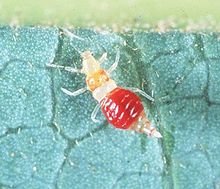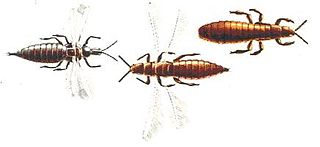
Thrips are minute, slender insects with fringed wings and unique asymmetrical mouthparts. Entomologists have described approximately 7,700 species. They fly only weakly and their feathery wings are unsuitable for conventional flight; instead, thrips exploit an unusual mechanism, clap and fling, to create lift using an unsteady circulation pattern with transient vortices near the wings.

Ant mimicry or myrmecomorphy is mimicry of ants by other organisms; it has evolved over 70 times. Ants are abundant all over the world, and potential predators that rely on vision to identify their prey, such as birds and wasps, normally avoid them, because they are either unpalatable or aggressive. Some arthropods mimic ants to escape predation, while some predators of ants, especially spiders, mimic them anatomically and behaviourally in aggressive mimicry. Ant mimicry has existed almost as long as ants themselves; the earliest ant mimics in the fossil record appear in the mid-Cretaceous alongside the earliest ants.
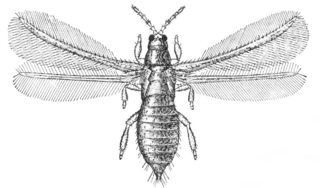
The Thripidae are the most speciose family of thrips, with over 290 genera representing just over two thousand species. They can be distinguished from other thrips by a saw-like ovipositor curving downwards, narrow wings with two veins, and antennae of six to ten antennomeres with stiletto-like forked sense cones on antennal segments III and IV.

The Aeolothripidae are a family of thrips. They are particularly common in the holarctic region, although several occur in the drier parts of the subtropics, including dozens in Australia. Adults and larvae are usually found in flowers, but they pupate on the ground. While they normally prey on other arthropods, many feed also on flowers.

Scirtothrips dorsalis, the chilli thrips or yellow tea thrips, is an extremely successful invasive species of pest-thrips which has expanded rapidly from Asia over the last twenty years, and is gradually achieving a global distribution. It has most recently been reported in St. Vincent (2004) Florida (2005), Texas (2006), and Puerto Rico (2007). It is a pest of economic significance with a broad host range, with prominent pest reports on crops including pepper, eggplant, mango, citrus, strawberry, grapes, cotton, tea, peanuts, blueberry, and roses. Chilli thrips appear to feed preferentially on new growth, and infested plants usually develop characteristic wrinkled leaves, with distinctive brown scarring along the veins of leaves, the buds of flowers, and the calyx of fruit. Feeding damage can reduce the sale value of crops produced, and in sufficient numbers, kill plants already aggravated by environmental stress. This thrips has also been implicated in the transmission of three tospoviruses, but there is some controversy over its efficiency as a vector.

The South American potato tuber moth, Andean potato tuber moth or tomato stemborer is a moth of the family Gelechiidae. It is native to South America, but has become a pest worldwide. Records include North America, Australia and New Zealand.
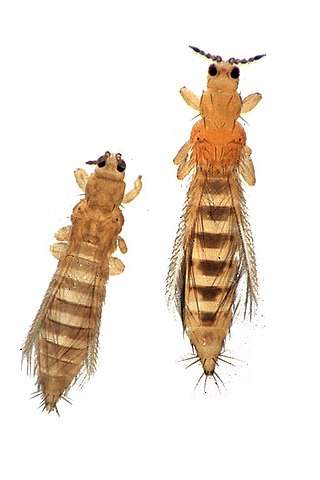
Thrips is a genus of insect in the order Thysanoptera.

Scirtothrips is a genus of thrips in the family Thripidae.
Uzelothrips is a genus of thrips, and the only genus in the family Uzelothripidae. Up until 2012 it contained a single species, U. scabrosus, known from Belém, Brazil; Brisbane, Australia; Singapore, and Angola. In 2012 a new extinct species, U. eocenicus, was described from the lowermost Eocene of France by Patricia Nel and André Nel in 2012. The species name refers to the age it existed in. The group name is in honour of Jindřich Uzel, a Czech entomologist who published the first monograph on the thrips. The family is identified by the whip-like tip to the antenna.
Neurothrips is a genus of tube-tailed thrips in the family Phlaeothripidae. There are about six described species in Neurothrips.

Erythrothrips is a genus of predatory thrips in the family Aeolothripidae. There are about 11 described species in Erythrothrips.

Aeolothrips is a genus of predatory thrips in the family Aeolothripidae. There are more than 80 described species in Aeolothrips.
Torvothrips is a genus of tube-tailed thrips in the family Phlaeothripidae. There are at least two described species in Torvothrips.
Merothripidae is a family of thrips in the order Thysanoptera. There are at least 4 genera and 20 described species in Merothripidae.
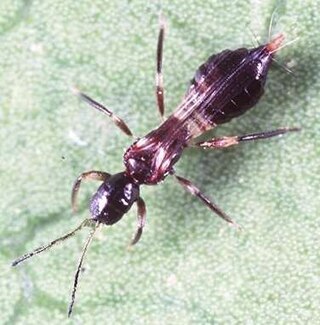
Franklinothrips vespiformis, the vespiform thrips, is a species of predatory thrip in the family Aeolothripidae. It is found in the Caribbean, Central America, North America, Oceania, South America, Southern Asia, and Europe. It has been used in biological control of Bemisia tabaci.
Heterothripidae is a family of thrips in the order Thysanoptera. There are about 6 genera and at least 70 described species in Heterothripidae.
Brakothrips is a genus of thrips in the family Phlaeothripidae, first described by Crespi, Morris and Mound in 2004. The type species is Brakothrips gillesi. Insects in this genus are found only in Australia, living under the splitting bark of young branches of Acacias.
Holothrips eurytis is a species of thrips in the Phlaeothripinae subfamily, first described in 2014 by Laurence Mound and Desley Tree. This species is found in New South Wales, the ACT and Queensland, and is endemic to Australia
Holothrips federicae is a species of thrips in the Phlaeothripinae subfamily, first described in 2014 by Laurence Mound and Desley Tree. This thrips is found in both New South Wales and Queensland, and is endemic to Australia.
Holothrips notialis is a species of thrips in the Phlaeothripinae subfamily, first described in 2014 by Laurence Mound and Desley Tree. This thrips is found in the Australian Capital Territory, New South Wales, South Australia, Tasmania, and Victoria, and is endemic to Australia.

